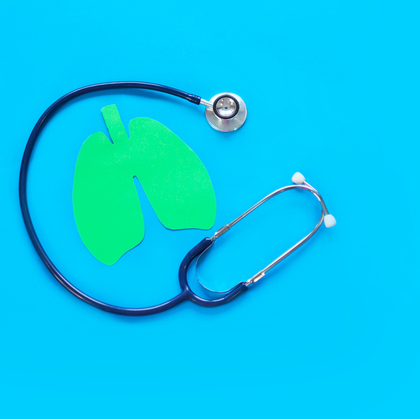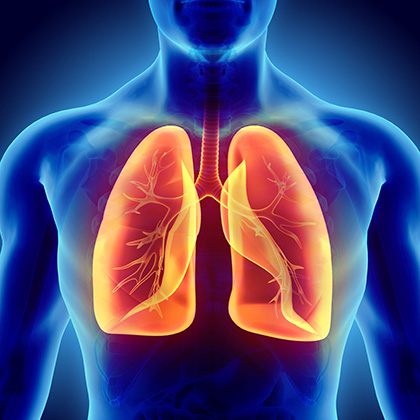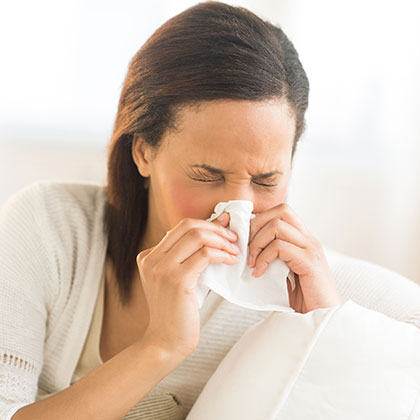
During the summer of 2020 – several months after the start of the coronavirus pandemic – health experts started to notice there was an increasing number of people who still had symptoms of the COVID-19 illness long after after they first caught and became ill with the virus.
According to the NHS, many people with COVID-19 feel better in a few days or weeks, with most making a full recovery within three months (i). However some – even those who had mild symptoms to start with – can still feel unwell for much longer.
Estimates as to how many people are affected by what we now informally know as long COVID vary from one study to another and change from one month to the next. But at the time of writing the latest figures from the Office for National Statistics suggest an estimated 1.3 million people in the UK have self-reported long COVID symptoms (defined by the ONS as symptoms persisting for more than four weeks after infection) (ii).
What causes long COVID?
There’s still no clear explanation for long COVID symptoms, though scientists have a number of theories, including that the symptoms may be caused an overactive immune system (if correct this would make long COVID an autoimmune disease).
Recently experts have also suggested that mitochondria – tiny structures found in almost all the body’s cells that generate energy – may play a part in causing some long COVID symptoms. One ongoing clinical trial taking place at the University of Oxford, for instance, is currently investigating the idea that damaged mitochondria causes fatigue and muscle weakness in people with long COVID (iii). The researchers are aiming to find out whether a drink containing a cocktail of amino acids might help by giving mitochondria extra fuel to produce energy. Experts elsewhere think mitochondria may be involved with other long COVID symptoms too.
What are long covid symptoms?
These figures also suggest 64 per cent of people with self-reported long COVID have symptoms that adversely affect their day-to-day activities, with 20 per cent saying their ability to perform day-to-day activities has been ‘limited a lot’. The most common symptoms include:
-
Fatigue (affecting 51 per cent of people with long COVID)
-
Loss of smell (37 per cent)
-
Shortness of breath (36 per cent)
-
Difficulty concentrating (28 per cent)
Those most affected, the report also found, are people aged 35 to 69, women, people living in deprived areas, people working in healthcare, social care or teaching and education, and those with another activity-limiting health condition or disability.
Long COVID has been officially named post COVID-19 condition by the World Health Organisation, which describes it as affecting approximately 10 - 20 per cent of people after they recover from their initial COVID-19 illness (iv). The condition is split into two types, depending on how long you have symptoms (v):
-
Ongoing symptomatic COVID is when you have symptoms for more than four weeks
-
Post-COVID syndrome is when your symptoms continue for 12 weeks or longer and cannot be explained by any other condition.
What are some of the other symptoms of long COVID?
There are many more symptoms of long COVID besides the most common ones listed above. Some symptoms can even appear after the initial illness has passed, while other symptoms may change over time too. The NHS has compiled a list of the main symptoms – though this is by no means comprehensive, as new symptoms are being discovered regularly as we find out more about the effects of the virus. The list includes the following (v):
General symptoms
-
Fever
Respiratory symptoms
-
Breathlessness
-
Cough
Cardiovascular symptoms
-
Tight chest
-
Chest pain
Musculoskeletal symptoms
-
Joint pain
-
Muscle pain
Gastrointestinal symptoms
-
Abdominal pain
-
Nausea
-
Reduced appetite in older people
-
Weight loss
Neurological symptoms
-
Brain fog (loss of concentration or memory problems)
-
Pins and needles, numbness (peripheral neuropathy)
-
Visual disturbance
-
Mobility problems
-
Delirium (in older people)
Psychological symptoms
-
Post-traumatic stress disorder (PTSD)
Ear, nose and throat symptoms
Dermatological symptoms
-
Skin rashes
Experts still don’t know what causes long COVID, though several theories have been put forward, including:
-
Toxins produced by the SARS-CoV-2 virus
-
Microvascular injury (abnormalities in the brain caused by the virus)
-
Micro-embolism (a small particle such as a blood clot blocking a blood vessel)
-
Endothelial damage (a type of coronary artery disease)
-
System-wide inflammation caused by the original infection
-
Low levels of certain antibodies (antibody signature)
How do I relieve the symptoms of long COVID at home?
If you have any of the symptoms of long COVID, your GP can recommend any further assessment, care or support you may need to help you feel better. Depending on your symptoms you may also be referred to a specialist rehabilitation service or a service that offers the relevant support.
Long COVID is a new condition, but as an increasing number of people are diagnosed with it, more help is becoming available for the physical as well as mental health symptoms. There is even a growing number of specialist clinics that support patients with long COVID, so it’s worth asking your GP about any help that may be available to you in your area.
Your GP can also give you advice on what you can do yourself to help your recovery and get back to your normal self faster. Some of the advice you might receive could include eating as healthily as you can and taking some exercise – though don’t push yourself too hard, work up gradually to a normal amount of exercise (150 minutes of moderate activity a week). Doing some exercise can also be good for your mood and help manage long COVID symptoms such as depression and anxiety.
It may also be a good idea to keep a symptom diary, listing any improvements or changes in your symptoms (this may help your GP or other healthcare professionals who are looking after you). Talking to other people who know what you’re going through can also be helpful – try chatting online via the Long COVID Support forum.
Meanwhile, here are some of the ways you can help yourself if you’re experiencing one or more of the following common symptoms:
Tiredness and fatigue
It’s not uncommon to feel wiped out after any illness, and COVID-19 is no exception. Fatigue is another word for extreme tiredness and is far more than simple tiredness – it’s when you find it impossible to do anything other than rest. To tackle it there are a few steps you can take, including:
-
Eating as well as you can and not skipping meals, even if you’re not hungry (try eating smaller, more frequent meals as this could help keep your blood sugar levels more stable)
-
Drinking plenty of water, as dehydration can make you feel even more tired
-
Getting as much sleep as you need {see our guide for tips on sleeping better)
-
Practising relaxation techniques (such as mindfulness, meditation and breathing exercises)
-
Pacing yourself by prioritising your physical and mental activities, and resting between activities
-
Getting help from others to do day-to-day tasks when your energy is particularly low (only do as much as you feel able to do)
-
Doing some exercise but building up your activity levels slowly – if you do too much too soon, you may make your fatigue worse
-
Taking nutritional supplements containing vitamins and minerals needed for normal energy production that may also help relieve tiredness and fatigue. These include several of the B vitamins (B2, B3, B5, B6, B12 and folate), vitamin C, vitamin D, magnesium and iron: a good-quality multivitamin and mineral supplement can supply convenient and appropriate levels of all these nutrients, or you can take each nutrient separately. For more information on which multivitamin would suit you best, take a look at our guide to multivitamins and daily requirements.
Loss of smell and taste
Many people lose or experience a change in their sense of smell and taste after having COVID-19, and it can take a while for their smell and taste to return. For instance, everything may hardly smell or taste of anything, with food tasting bland and unappetising or too salty, too sweet or even metallic. Certain smells may seem particularly unpleasant too, or you may experience a bad smell all of the time. All of these things can affect your appetite, especially if any changes to your sense of smell or taste have become a long-term problem.
There are a few things you could try to make life a little easier while your sense of taste and smell start to recover, including:
-
Brush your teeth at least twice a day to keep your mouth clean and healthy
-
If food tastes bland experiment with lots of different strong flavours, such as herbs and spices (though try to avoid having too much salt or sugar)
-
If food tastes and smells unpleasant, try taking very small mouthfuls rather than eating normally (this may help you get used to the new taste)
-
Avoid eating hot food – leave it until it’s cooler or at room temperature before you eat
-
If your mouth feels dry or uncomfortable, rinse with water – but steer clear of alcohol-based mouthwash
-
If your sense of smell has completely disappeared take care if you’re using a gas cooker – make sure it’s switched off properly, as you won’t be able to smell the gas if it isn’t – and check all your smoke alarms are in good working order
-
Practice smelling things with strong odours, such as perfumes, coffee, essential oils or strong cheeses – this may help if you have some sense of smell (but not if your smell has gone completely)
-
Try taking vitamin A, as there’s some evidence it may help treat loss of smell after an infection. One study suggests vitamin A nasal drops may help repair tissue in the nose damaged by a virus (vi), so it may be worth trying to eat more vitamin A-rich foods – such as oily fish, milk, cheese, eggs, liver and fortified low-fat spreads – or taking a vitamin A supplement. However, avoid taking vitamin A or eating foods that are very rich sources of vitamin A (liver, for instance) if you’re a woman who’s pregnant or likely to become pregnant.
Meanwhile read more about a condition that causes a strange taste in your mouth in our guide to dysgeusia
Aching joints and muscles
Joint and muscle problems are common with and after a bout of COVID-19, especially if you were ill for a while and you weren’t very active while you had the virus. Any aches in your joints and muscles should wear off when you start moving about more again, but for some people the pain can last for longer.
Some of the things you can do to ease joint and muscle problems include:
-
Stretching your muscles regularly – but take it easy, don’t push yourself too hard
-
Doing some strength exercises to build your muscles up again (increase the amount of exercise you do slowly and take lots of rests while you’re doing them – it’s important not to wear yourself out)
-
Take over-the-counter painkillers if you need to – find out more about pain medicines by reading our guide to pain relief remedies
-
Try supplements containing nutrients that support normal muscle function, including vitamin D, magnesium, potassium and calcium (you may find it more convenient to get all of these together in a good-quality multivitamin and mineral supplement)
-
Find something that helps you feel more relaxed, as it may help reduce the stress of being in constant pain
Brain fog
This is a common in long COVID and is an informal term for a range of symptoms including poor concentration, forgetfulness, confusion and mental fatigue. It can, for instance, make you feel as if you haven’t had much sleep or you’re under a lot of stress. The good news is your brain isn’t likely to have suffered any structural damage, so you should recover and get back to normal in time. Here’s what you can do to help speed up the recovery process:
-
Drink plenty of water to stay hydrated
-
Get plenty of sleep (if you’re struggling with sleep issues, check out our guide to insomnia for tips on sleeping better)
-
Take regular breaks if you’re doing something that requires focus or concentration
-
Try giving your brain regular mini holiday by learning how to meditate
-
Eat at least one portion of oily fish each week (though avoid having more than one portion if you’re a woman of childbearing age who’s pregnant or breastfeeding or who may become pregnant). The omega-3 fatty acids found in oily fish such as salmon, pilchards, sardines, mackerel and herring are considered important for a healthy brain, with studies suggesting they’re important for helping brain cells communicate with one another (vii). If you’re a vegan or vegetarian you can also benefit from the same important fatty acids found in oily fish by taking an omega-3 supplement sourced from marine algae.
If, however, you’re experiencing more serious memory or concentration problems after having COVID-19, you may need treatment called cognitive rehabilitation from an occupational therapist or psychologist – your GP or specialist can explain your options.
Headaches
It’s common to experience a thumping headache when you have COVID-19, but for some the headaches can continue long after the other symptoms have subsided.
If your headaches are severe or if you have migraines while recovering from COVID-19, your GP may prescribe painkillers that are stronger than those you find over the counter. But if ordinary painkillers will do the trick, try some paracetamol or ibuprofen – though avoid ibuprofen if you’re a woman who’s pregnant or if you’re allergic to aspirin or other ibuprofen-like drugs such as naproxen. Ibuprofen also may not be suitable for you if you have another medical condition – check with your GP or a pharmacist if you’re not sure.
Other things you can do to relieve headaches include:
-
Drinking less alcohol (only drink in moderation)
-
Drinking plenty of water to avoid dehydration
-
Getting plenty of sleep
-
Making time for relaxation
-
Eating more oily fish or taking fish-oil supplements (or algae-based supplements if you’re vegetarian or vegan) – the omega-3 fatty acids found in oily fish and marine algae may be particularly useful if you’re having migraines, as researchers have found having a diet rich in omega-3s may help reduce the frequency and intensity of migraine attacks (viii).
Take a look at our guides to headaches and migraines for more information on managing their symptoms.
Long COVID hasn’t been around for very long so scientists are still finding out what may or may not cause it, why some people are affected by it but not others, and what treatments or remedies may help reduce the symptoms. In the meantime, this guide shows there’s lots you can do yourself that may be helpful while you’re recovering and getting back on your feet. To find out more about a range of other health conditions, take a tour around our pharmacy health library.
References:
(i) Available online: https://www.nhs.uk/conditions/coronavirus-covid-19/long-term-effects-of-coronavirus-long-covid/
(ii) Available online: https://www.ons.gov.uk/peoplepopulationandcommunity/healthandsocialcare/conditionsanddiseases/bulletins/prevalenceofongoingsymptomsfollowingcoronaviruscovid19infectionintheuk/6january2022
(iii) Available online: https://www.stx.ox.ac.uk/article/dr-betty-raman-leads-new-study-on-potential-treatment-for-fatigue-in-long-covid-patients
(iv) Available online: https://www.who.int/news-room/questions-and-answers/item/coronavirus-disease-(covid-19)-post-covid-19-condition
(v) Available online: https://www.yourcovidrecovery.nhs.uk/what-is-covid-19/long-covid/
(vi) Hummel T et al. Intranasal vitamin A is beneficial in post-infectious olfactory loss. Otorhinolaryngol. 2017 Jul;274(7):2819-2825. Available online: https://link.springer.com/article/10.1007%2Fs00405-017-4576-x
(vii) Dyall SC. Long-chain omega-3 fatty acids and the brain: a review of the independent and shared effects of EPA, DPA and DHA. Front Aging Neurosci. 2015; 7: 52. Available online: https://www.ncbi.nlm.nih.gov/pmc/articles/PMC4404917/
(viii) Ramsden CE et al. Dietary alteration of n-3 and n-6 fatty acids for headache reduction in adults with migraine: randomized controlled trial. BMJ 2021; 374. Available online: https://www.bmj.com/content/374/bmj.n1448
Related Posts
Disclaimer: The information presented by Nature's Best is for informational purposes only. It is based on scientific studies (human, animal, or in vitro), clinical experience, or traditional usage as cited in each article. The results reported may not necessarily occur in all individuals. Self-treatment is not recommended for life-threatening conditions that require medical treatment under a doctor's care. For many of the conditions discussed, treatment with prescription or over the counter medication is also available. Consult your doctor, practitioner, and/or pharmacist for any health problem and before using any supplements or before making any changes in prescribed medications.

Christine
Christine Morgan has been a freelance health and wellbeing journalist for almost 20 years, having written for numerous publications including the Daily Mirror, S Magazine, Top Sante, Healthy, Woman & Home, Zest, Allergy, Healthy Times and Pregnancy & Birth; she has also edited several titles such as Women’ Health, Shine’s Real Health & Beauty and All About Health.
View More



